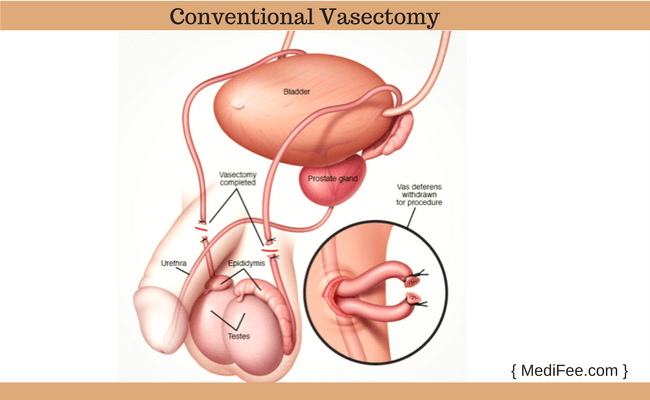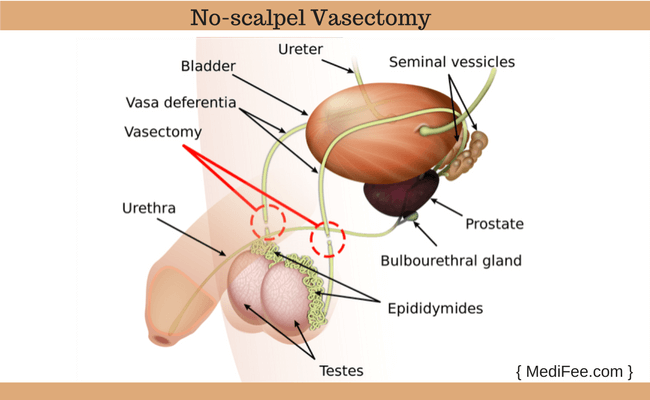Vasectomy
Listed below is the step by step procedure of vasectomy:
- What is Vasectomy?
- Why is Vasectomy Required?
- Pre-operative Preparation
- Day Before Surgery
- Procedure Day
- Methods/Techniques of Vasectomy
- Post Procedure
- Risks and Complications
- FAQs
What is Vasectomy?
Vasectomy is a method of contraception in males; commonly called as male sterilization. It is relatively quick and painless surgery which involves cutting or blocking of two tubes called vas deferens after which sperms can not get into the semen. These tubes carry sperms to the penis from the testicles of a man. After blocking these tubes, sperms get prevented from entering into the semen.

Semen or seminal fluid is the fluid ejaculated from the penis during sex. Patients can still have erections after vasectomy and can ejaculate normally. Absence of sperms in the semen as a result of vasectomy process results in no fertilization of woman's ovum (egg). This is why, after vasectomy, a man can not make a woman pregnant.
Usually vasectomy is carried out under general anesthetic. It in a very short process of around 15 minutes. The process of vasectomy is less costly than the female sterilization process as well as long term medications for birth control.
Sterilization is a permanent decision and needs to be taken very thoughtfully. There are some men with no desire of having children. It is a lifelong commitment to be a father which comes with responsibilities. In general, vasectomy is considered as a permanent birth control method even though there are options of vasectomy reversal. This reversal process in not easy and expensive in nature. 40-75% success rate is observed in pregnancies after the vasectomy reversal.
Why is Vasectomy Required?
Generally, going for a vasectomy is a personal choice. Mainly it is carried out as a birth control method to avoid unwanted pregnancy. While going for vasectomy few things need to be considered by men. It needs to be done for right reasons. There should not be pressure from an intimate partner or spouse. For emotional and financial reasons, vasectomy should not be performed. Men undergoing this process need to be confident enough about family life and children issues. The best candidates for vasectomy are:
- Men with emotional maturity for permanent decision makingc
- Men who are secure with present number of children
- Men who are secure with decision of not having any more children
- Men who are concerned about passing a genetic trait or hereditary disability to their children
Pre-operative Preparations
Prior to surgery, patient needs to get complete idea about possibilities post surgery including complications if any. All instructions given by the surgeon need to be followed.
Few days before the surgery, a consent form needs to be filled by the patient. This allows doctors to proceed with the surgery. Consent form states that is is not guaranteed to make the patient sterile after vasectomy. History of scrotal surgery needs to be informed to the surgeon.
Drugs, such as Ibuprofen, Naproxen and Aspirin are not allowed to take prior to few days of surgery since they can cause bleeding post surgery. Also, patients need to inform the surgeon if they are already taking any other medications. A close relative or friend is required to accompany the patient so that they feel better after surgery.
Day before Surgery
A day before surgery, basic test records need to be kept handy for avoiding complications. Everything required for the surgery needs to be organized. This includes basic requirements for cleanliness such as toiletries.
Procedure Day
On the morning of the surgery, patient needs to maintain cleanliness. It includes a shower and cleaning of scrotum. Shaving of scrotum needs to be done as per the advice of the surgeon. Eating and drinking instructions need to be followed as per the advice of the surgeon.
Methods/Techniques of Vasectomy
Most of the times, local anesthesia is given prior to vasectomy. This makes the scrotum and testicles of the patient unconscious or numb. Patient will remain awake during the surgery. No pain is experienced but there will be slight discomfort. In some men, it is difficult to get access to the vas deferens. In such rare cases, general anesthesia is recommended. In patients having allergy to local anesthetic or history of fainting, general anesthesia is used.
Methods of Vasectomy
Two types of vasectomy are available. Based on the patient, surgeons decide which type of vasectomy needs to be carried out.
- Conventional vasectomy
- No-scalpel vasectomy
Conventional Vasectomy
Conventional vasectomy is a traditional method. It involves making of two mini incisions of around 1cm in the scrotum once it is anesthetized with local anesthesia. Scrotum is the pouch of the skin which surrounds the testicles of a man.

This incision making is carried out with the help of scalpel or surgical knife. These incisions allow the surgeon to access the vas deferens; tubes which carry the sperms from the testicles. From each tube, a small section is removed, ends of the tubes are tied or sealed with an instrument which heats to a very high temperature. This instrument is known as diathermy. Stitching of incisions is carried out using dissolvable stitches. These stitches usually disappear within a week naturally.
No-scalpel Vasectomy
This is a new method in which no scalpels are used. This is used now commonly. During no-scalpel vasectomy, vas deferens can be felt by the surgeon underneath the skin of the scrotum and using a tiny clamp, they are held in place.

A tiny puncture hole is made by using a special kind of instrument in the scrotum skin. A tiny pair of forceps can be used for opening this hole for accessing the vas deferens. No incision making is required here using scalpel. These tubes get tied or sealed in the similar manner as that of in conventional vasectomy. In no-scalpel vasectomy process, little bleeding is involved and no stitches are required. Along with this, pain is experienced after no-scalpel method and lesser number of complications are seen compared to conventional vasectomy.
Post Procedure
In most cases, patient can return home on the same day of surgery. The scrotum of the patient looks bruised and swollen for about a week. There can be some bloody discharge from the incisions.
Given below are the tips to be followed by the patients for faster recovery:
- For some days, patient needs to lie down and take enough rest.
- Athletic supporter or snug cotton briefs need to be worn for support.
- Swelling can be reduced with the help of ice pack or bag of frozen peas. These items need to be kept in towel and then this towel needs to be placed on the scrotum.
- For relieving symptoms of pain and discomfort, painkillers as suggested by the doctor can be consumed.
- Strenuous activities need to be avoided.
Risks and Complications
Following are the side effects observed right after vasectomy.
- Hematoma (blood clot) inside the scrotum
- Blood in the semen
- Infection at the site of surgery
- Discomfort
- Swelling
- Bruising of your scrotum
Listed below are delayed complications post surgery.
- Fluid build up in the testicle
- Granuloma
- Chronic pain in rare cases
- Abnormal cyst formation in epididymis
- Bleeding into the scrotum
- Post vasectomy pain syndrome (explained in brief below)
Post vasectomy pain syndrome
In some patients, chronic testicular or epididymal pain gets developed after vasectomy. This pain may start right after vasectomy procedure and it can be a result of sperm granuloma or infection. It can be reduced with the help of medications in most of the patients.
Pain can be developed after few years of vasectomy in some cases on occasional basis. This can be due to back pressure formed in the epididymis and known as post vasectomy pain syndrome or epididymal blowout. Treatments for this condition include open-end vasectomy and chemical sterilization and vasectomy reversal.
FAQs
- Can vasectomy make a man impotent?
A. There is no effect of vasectomy on the sexual function of a man. It is not near the penis and its nerves. On the contrary, it has been found that sex life is improved post vasectomy due to lack of fear of unwanted pregnancy.
- When can the results of vasectomy be seen?
A. One cannot get the vasectomy results right away after completion of procedure. It requires as many as 15-20 times ejaculations or three months waiting period prior to get the sperm cleared from both of the vas deferens. Doctors recommend analysis of ejaculation samples after two or three months post vasectomy. It is only after observing sperm-free sample, patient is considered as sterile.
- What is the impact of vasectomy on semen volume?
A. There is no effect of vasectomy on semen volume. There is a common misconception of “shoot blanks†in men after vasectomy which is not real. Semen volume of around 98% is from the prostate and seminal vesicles. That is why, there is no noticeable smell, appearance or taste of semen observed. Whether a man has undergone vasectomy or not can be identified only under microscope by confirming absence of sperms.

